flat tire TOYOTA BZ4X 2022 Owners Manual (in English)
[x] Cancel search | Manufacturer: TOYOTA, Model Year: 2022, Model line: BZ4X, Model: TOYOTA BZ4X 2022Pages: 674, PDF Size: 120.02 MB
Page 3 of 674
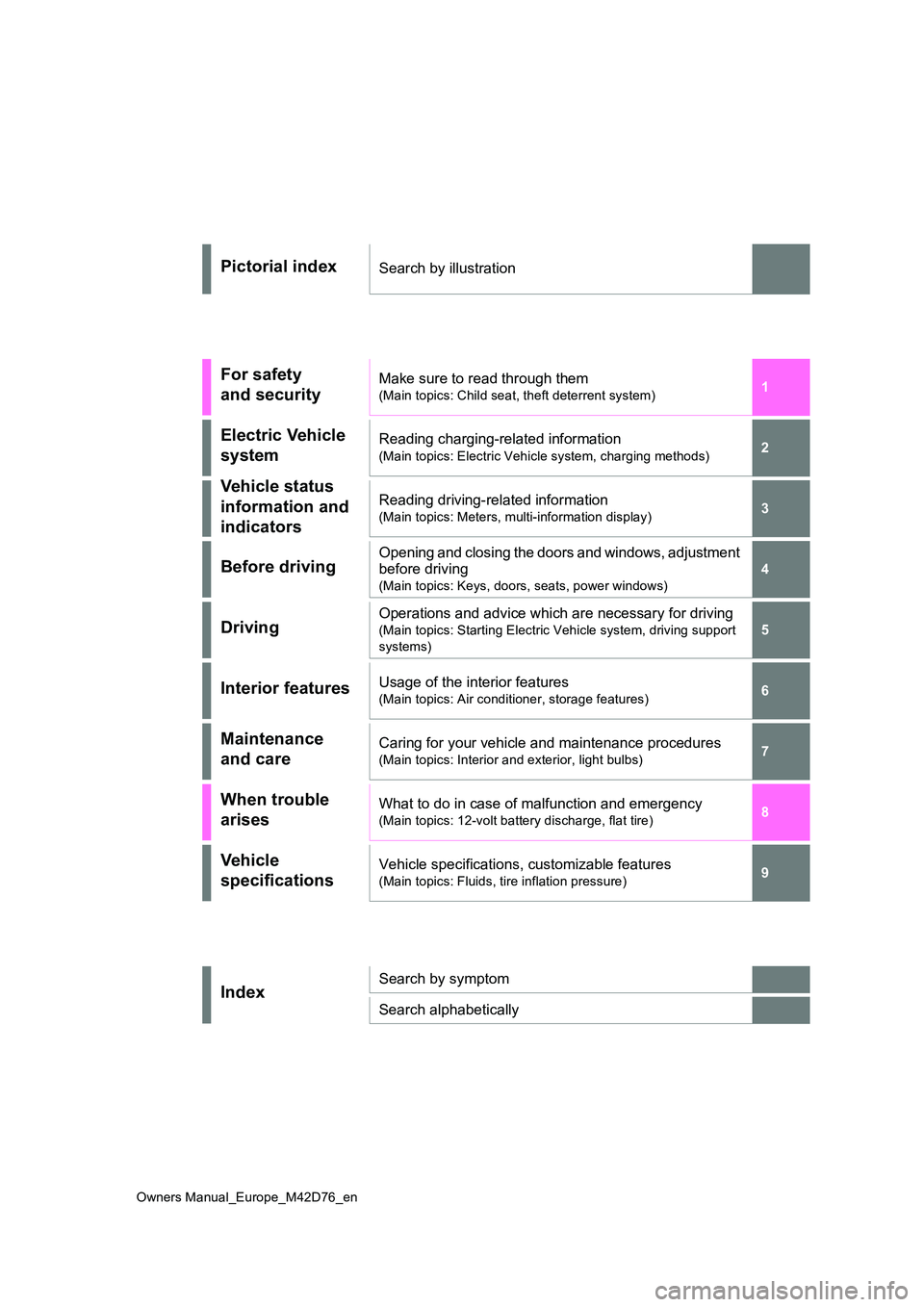
1
6
5
4
3
2
8
7
9
Owners Manual_Europe_M42D76_en
Pictorial indexSearch by illustration
For safety
and security
Make sure to read through them
(Main topics: Child seat, theft deterrent system)
Electric Vehicle
system
Reading charging-related information
(Main topics: Electric Vehicle system, charging methods)
Vehicle status
information and
indicators
Reading driving-related information
(Main topics: Meters, multi-information display)
Before drivingOpening and closing the doors and windows, adjustment
before driving
(Main topics: Keys, doors, seats, power windows)
DrivingOperations and advice which are necessary for driving
(Main topics: Starting Electric Vehicle system, driving support
systems)
Interior featuresUsage of the interior features
(Main topics: Air conditioner, storage features)
Maintenance
and care
Caring for your vehicle and maintenance procedures
(Main topics: Interior and exterior, light bulbs)
When trouble
arises
What to do in case of malfunction and emergency
(Main topics: 12-volt battery discharge, flat tire)
Vehicle
specifications
Vehicle specifications, customizable features
(Main topics: Fluids, tire inflation pressure)
IndexSearch by symptom
Search alphabetically
Page 7 of 674
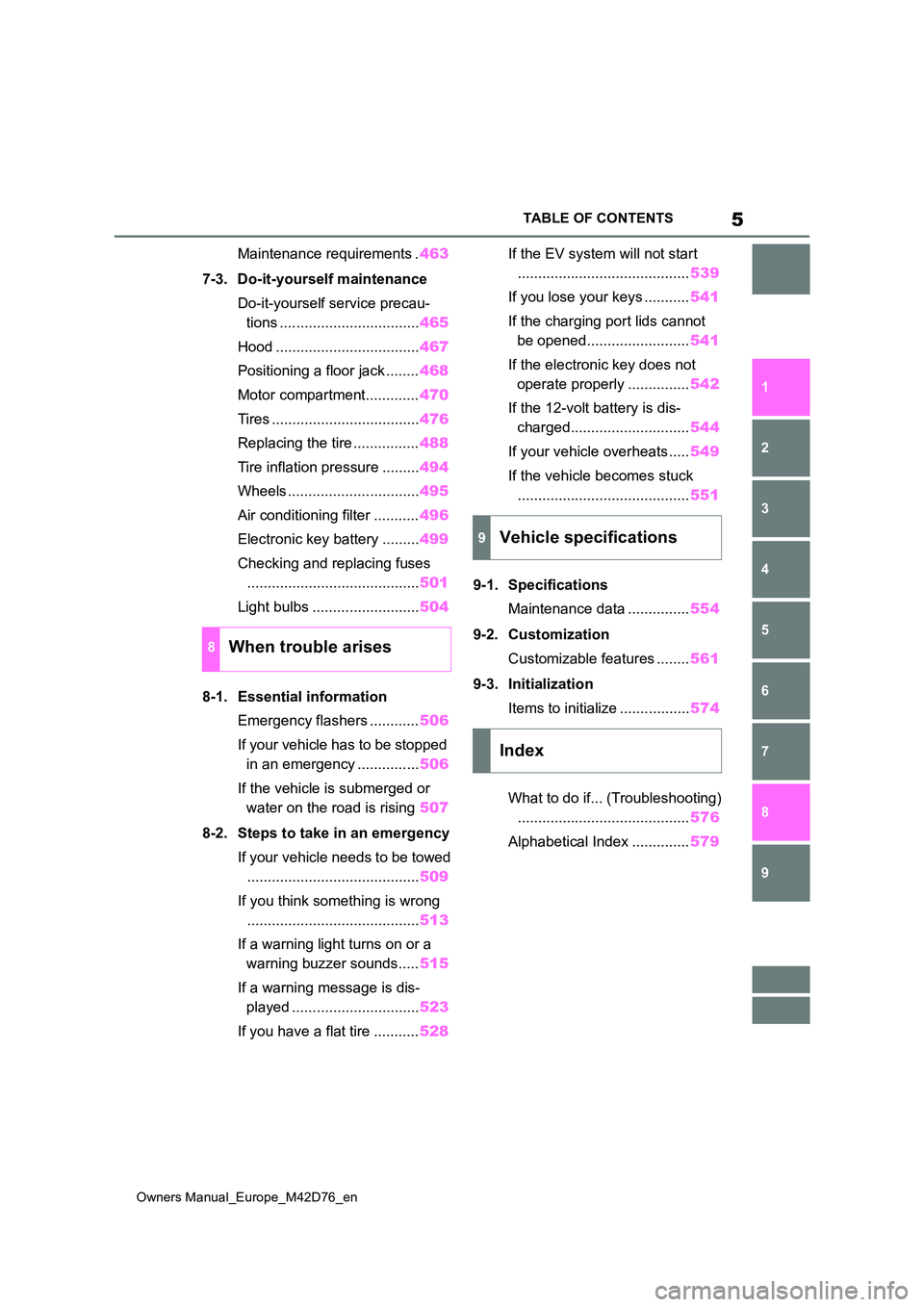
5
Owners Manual_Europe_M42D76_en
TABLE OF CONTENTS
1
6
5
4
3
2
8
7
9
Maintenance requirements . 463
7-3. Do-it-yourself maintenance
Do-it-yourself service precau-
tions .................................. 465
Hood ................................... 467
Positioning a floor jack ........ 468
Motor compartment............. 470
Tires .................................... 476
Replacing the tire ................ 488
Tire inflation pressure ......... 494
Wheels ................................ 495
Air conditioning filter ........... 496
Electronic key battery ......... 499
Checking and replacing fuses
.......................................... 501
Light bulbs .......................... 504
8-1. Essential information
Emergency flashers ............ 506
If your vehicle has to be stopped
in an emergency ............... 506
If the vehicle is submerged or
water on the road is rising 507
8-2. Steps to take in an emergency
If your vehicle needs to be towed
.......................................... 509
If you think something is wrong
.......................................... 513
If a warning light turns on or a
warning buzzer sounds..... 515
If a warning message is dis-
played ............................... 523
If you have a flat tire ........... 528
If the EV system will not start
.......................................... 539
If you lose your keys ........... 541
If the charging port lids cannot
be opened......................... 541
If the electronic key does not
operate properly ............... 542
If the 12-volt battery is dis-
charged............................. 544
If your vehicle overheats ..... 549
If the vehicle becomes stuck
.......................................... 551
9-1. Specifications
Maintenance data ............... 554
9-2. Customization
Customizable features ........ 561
9-3. Initialization
Items to initialize ................. 574
What to do if... (Troubleshooting)
.......................................... 576
Alphabetical Index .............. 579
8When trouble arises
9Vehicle specifications
Index
Page 15 of 674
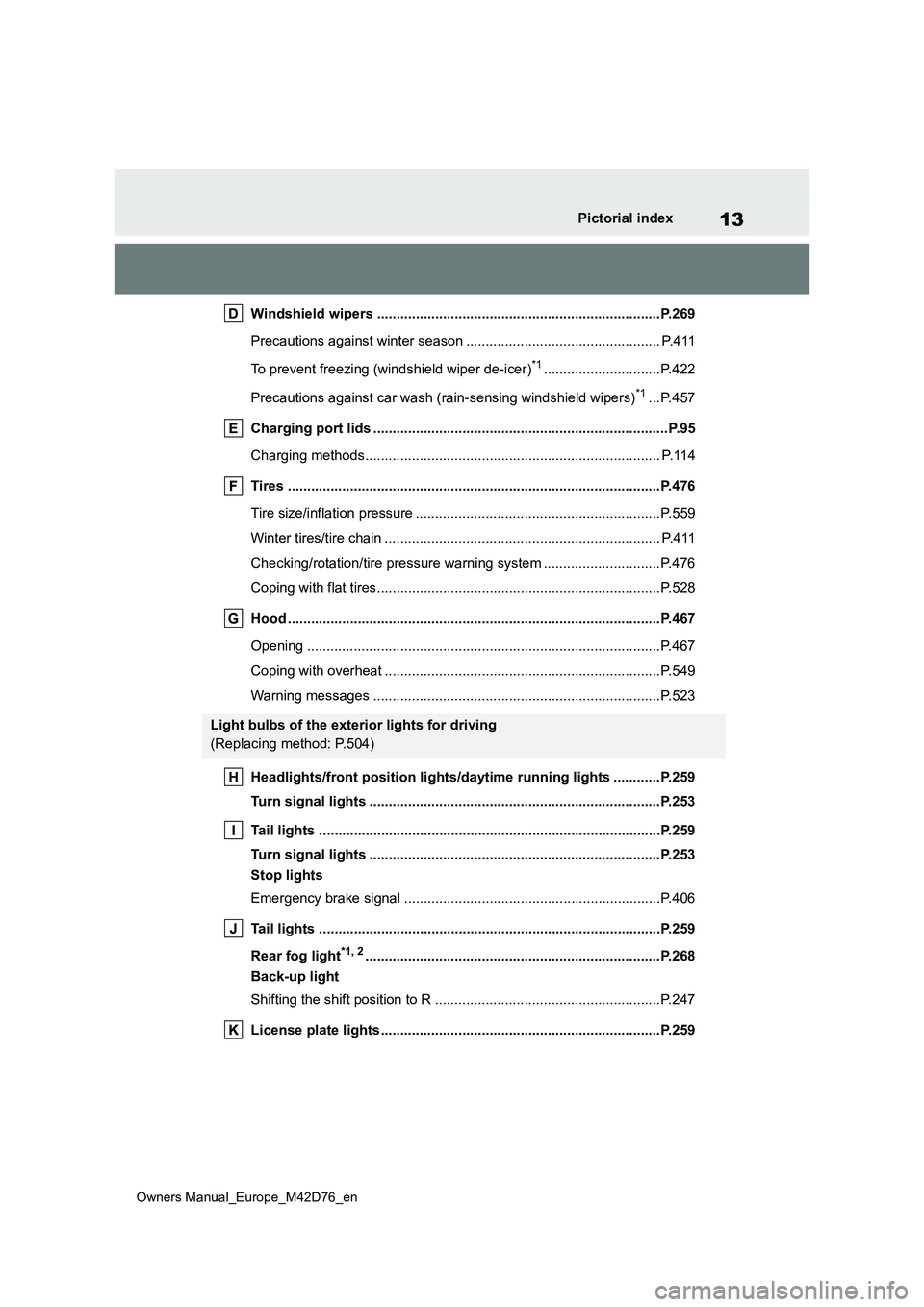
13
Owners Manual_Europe_M42D76_en
Pictorial index
Windshield wipers .........................................................................P.269
Precautions against winter season .............................. .................... P.411
To prevent freezing (windshield wiper de-icer)*1..............................P.422
Precautions against car wash (rain-sensing windshield wipers)*1...P.457
Charging port lids ............................................. ...............................P.95
Charging methods............................................... ............................. P.114
Tires .......................................................... ......................................P.476
Tire size/inflation pressure ................................... ............................P.559
Winter tires/tire chain ........................................ ............................... P.411
Checking/rotation/tire pressure warning system ................. .............P.476
Coping with flat tires......................................... ................................P.528
Hood ........................................................... .....................................P.467
Opening ........................................................ ...................................P.467
Coping with overheat ........................................... ............................P.549
Warning messages ............................................... ...........................P.523
Headlights/front position lights/daytime running lights ........ ....P.259
Turn signal lights ............................................. ..............................P.253
Tail lights .................................................... ....................................P.259
Turn signal lights ............................................. ..............................P.253
Stop lights
Emergency brake signal ......................................... .........................P.406
Tail lights .................................................... ....................................P.259
Rear fog light*1, 2............................................................... .............P.268
Back-up light
Shifting the shift position to R ............................... ...........................P.247
License plate lights........................................... .............................P.259
Light bulbs of the exterior lights for driving
(Replacing method: P.504)
Page 94 of 674
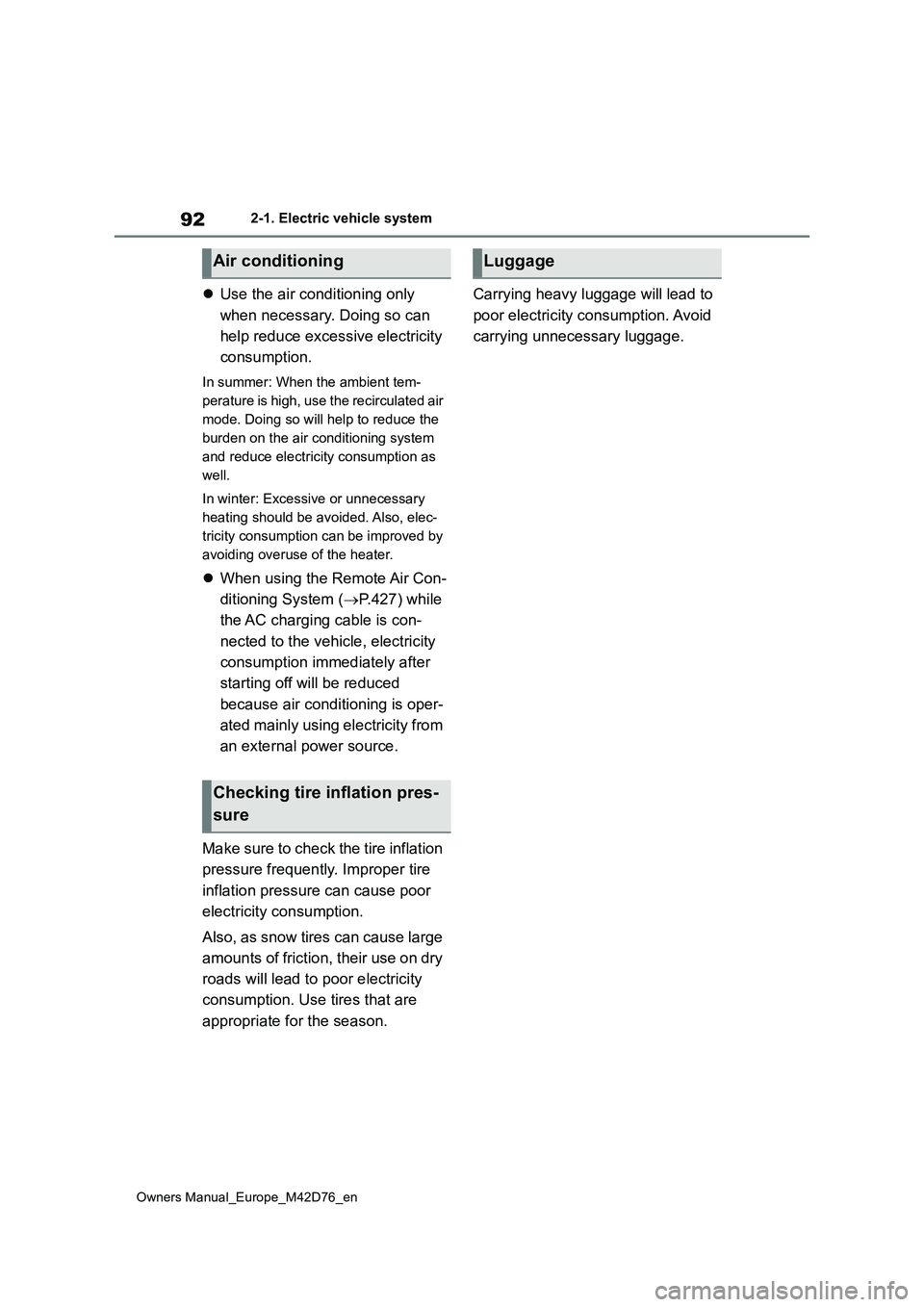
92
Owners Manual_Europe_M42D76_en
2-1. Electric vehicle system
Use the air conditioning only
when necessary. Doing so can
help reduce excessive electricity
consumption.
In summer: When the ambient tem-
perature is high, use the recirculated air
mode. Doing so will help to reduce the
burden on the air conditioning system
and reduce electricity consumption as
well.
In winter: Excessive or unnecessary
heating should be avoided. Also, elec-
tricity consumption can be improved by
avoiding overuse of the heater.
When using the Remote Air Con-
ditioning System ( P.427) while
the AC charging cable is con-
nected to the vehicle, electricity
consumption immediately after
starting off will be reduced
because air conditioning is oper-
ated mainly using electricity from
an external power source.
Make sure to check the tire inflation
pressure frequently. Improper tire
inflation pressure can cause poor
electricity consumption.
Also, as snow tires can cause large
amounts of friction, their use on dry
roads will lead to poor electricity
consumption. Use tires that are
appropriate for the season.
Carrying heavy luggage will lead to
poor electricity consumption. Avoid
carrying unnecessary luggage.
Air conditioning
Checking tire inflation pres-
sure
Luggage
Page 180 of 674
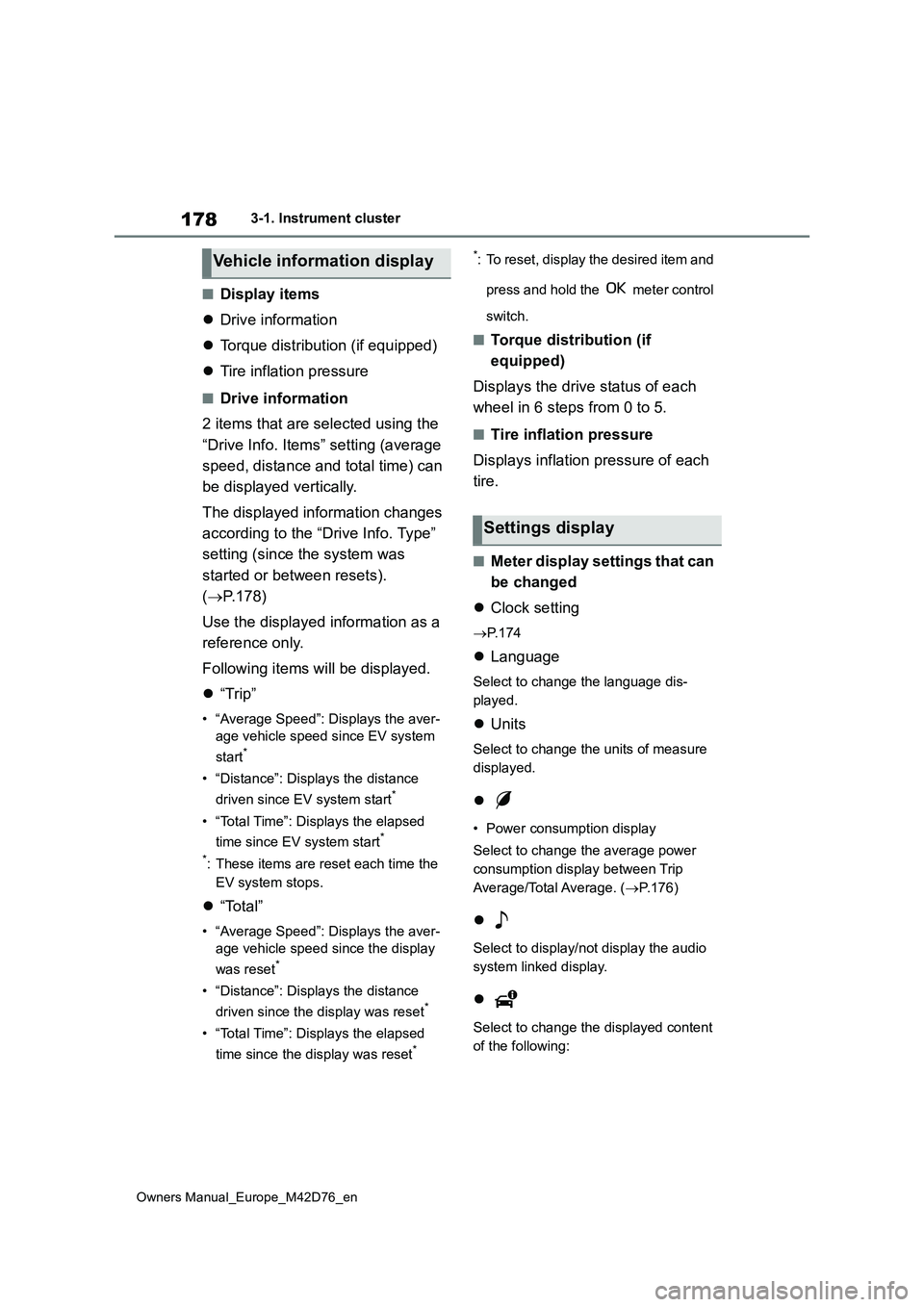
178
Owners Manual_Europe_M42D76_en
3-1. Instrument cluster
■Display items
Drive information
Torque distribution (if equipped)
Tire inflation pressure
■Drive information
2 items that are selected using the
“Drive Info. Items” setting (average
speed, distance and total time) can
be displayed vertically.
The displayed information changes
according to the “Drive Info. Type”
setting (since the system was
started or between resets).
( P.178)
Use the displayed information as a
reference only.
Following items will be displayed.
“Trip”
• “Average Speed”: Displays the aver-
age vehicle speed since EV system
start*
• “Distance”: Displays the distance
driven since EV system start*
• “Total Time”: Displays the elapsed
time since EV system start*
*: These items are reset each time the
EV system stops.
“Total”
• “Average Speed”: Displays the aver-
age vehicle speed since the display
was reset*
• “Distance”: Displays the distance
driven since the display was reset*
• “Total Time”: Displays the elapsed
time since the display was reset*
*: To reset, display the desired item and
press and hold the meter control
switch.
■Torque distribution (if
equipped)
Displays the drive status of each
wheel in 6 steps from 0 to 5.
■Tire inflation pressure
Displays inflation pressure of each
tire.
■Meter display settings that can
be changed
Clock setting
P. 1 7 4
Language
Select to change the language dis-
played.
Units
Select to change the units of measure
displayed.
• Power consumption display
Select to change the average power
consumption display between Trip
Average/Total Average. ( P.176)
Select to display/not display the audio
system linked display.
Select to change the displayed content
of the following:
Vehicle information display
Settings display
Page 236 of 674
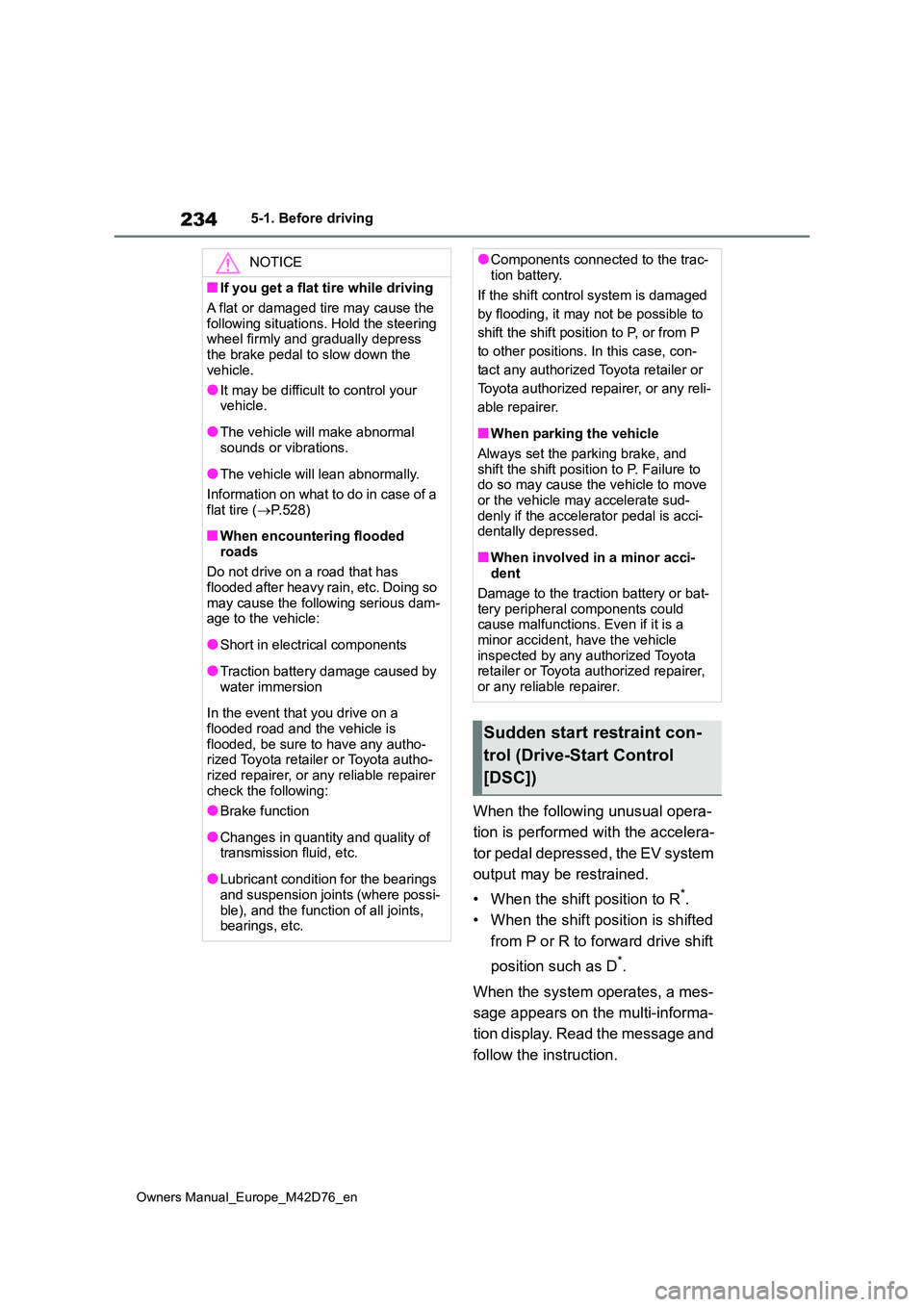
234
Owners Manual_Europe_M42D76_en
5-1. Before driving
When the following unusual opera-
tion is performed with the accelera-
tor pedal depressed, the EV system
output may be restrained.
• When the shift position to R*.
• When the shift position is shifted
from P or R to forward drive shift
position such as D*.
When the system operates, a mes-
sage appears on the multi-informa-
tion display. Read the message and
follow the instruction.
NOTICE
■If you get a flat tire while driving
A flat or damaged tire may cause the
following situations. Hold the steering wheel firmly and gradually depress the brake pedal to slow down the
vehicle.
●It may be difficult to control your vehicle.
●The vehicle will make abnormal sounds or vibrations.
●The vehicle will lean abnormally.
Information on what to do in case of a
flat tire ( P.528)
■When encountering flooded
roads
Do not drive on a road that has flooded after heavy rain, etc. Doing so
may cause the following serious dam- age to the vehicle:
●Short in electrical components
●Traction battery damage caused by
water immersion
In the event that you drive on a
flooded road and the vehicle is flooded, be sure to have any autho-rized Toyota retailer or Toyota autho-
rized repairer, or any reliable repairer check the following:
●Brake function
●Changes in quantity and quality of transmission fluid, etc.
●Lubricant condition for the bearings and suspension joints (where possi-
ble), and the function of all joints, bearings, etc.
●Components connected to the trac-tion battery.
If the shift control system is damaged
by flooding, it may not be possible to
shift the shift position to P, or from P
to other positions. In this case, con-
tact any authorized Toyota retailer or
Toyota authorized repairer, or any reli-
able repairer.
■When parking the vehicle
Always set the parking brake, and
shift the shift position to P. Failure to do so may cause the vehicle to move or the vehicle may accelerate sud-
denly if the accelerator pedal is acci- dentally depressed.
■When involved in a minor acci-dent
Damage to the traction battery or bat-
tery peripheral components could cause malfunctions. Even if it is a minor accident, have the vehicle
inspected by any authorized Toyota retailer or Toyota authorized repairer, or any reliable repairer.
Sudden start restraint con-
trol (Drive-Start Control
[DSC])
Page 240 of 674
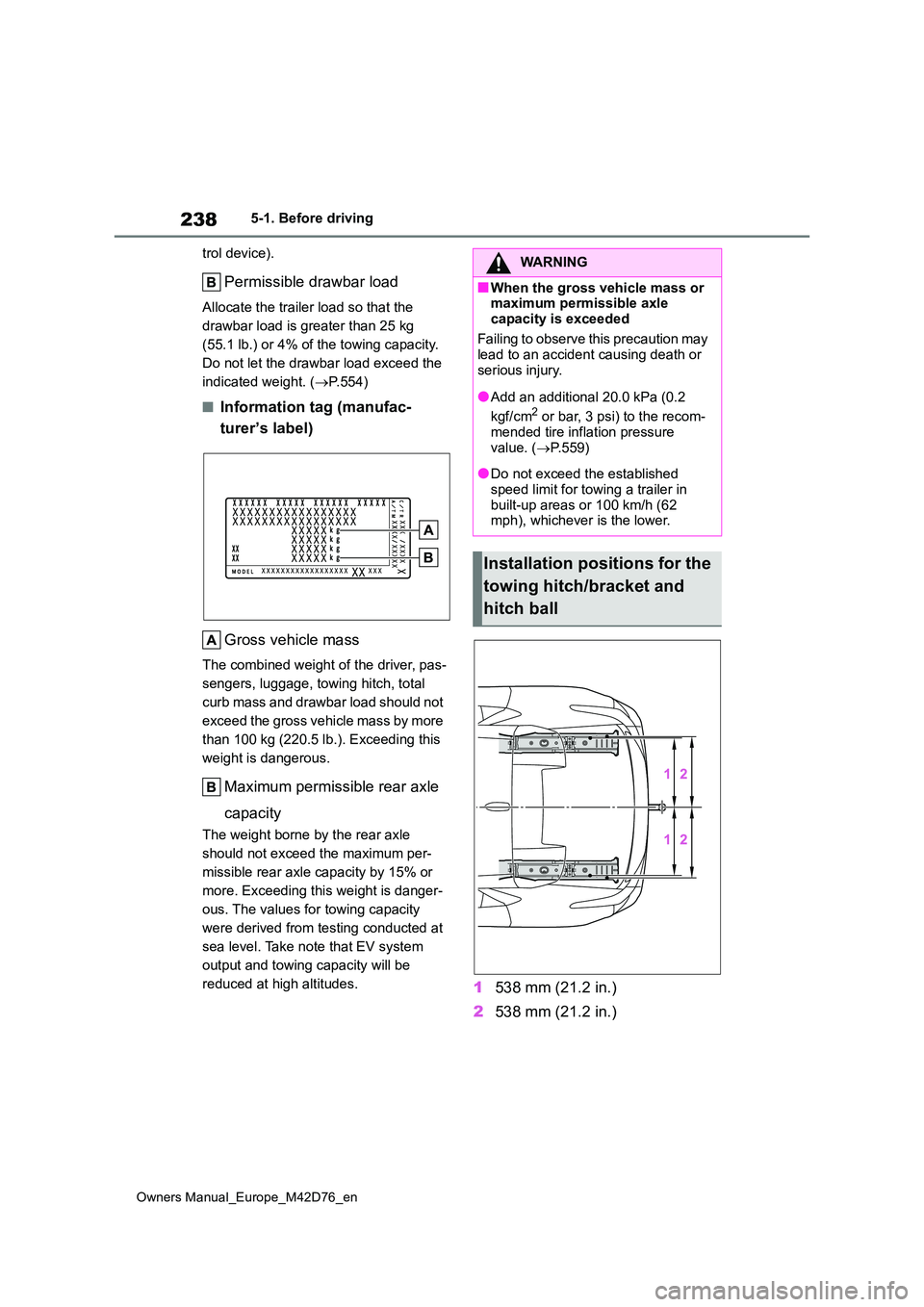
238
Owners Manual_Europe_M42D76_en
5-1. Before driving
trol device).
Permissible drawbar load
Allocate the trailer load so that the
drawbar load is greater than 25 kg
(55.1 lb.) or 4% of the towing capacity.
Do not let the drawbar load exceed the
indicated weight. ( P.554)
■Information tag (manufac-
turer’s label)
Gross vehicle mass
The combined weight of the driver, pas-
sengers, luggage, towing hitch, total
curb mass and drawbar load should not
exceed the gross vehicle mass by more
than 100 kg (220.5 lb.). Exceeding this
weight is dangerous.
Maximum permissible rear axle
capacity
The weight borne by the rear axle
should not exceed the maximum per-
missible rear axle capacity by 15% or
more. Exceeding this weight is danger-
ous. The values for towing capacity
were derived from testing conducted at
sea level. Take note that EV system
output and towing capacity will be
reduced at high altitudes.1 538 mm (21.2 in.)
2 538 mm (21.2 in.)
WARNING
■When the gross vehicle mass or maximum permissible axle
capacity is exceeded
Failing to observe this precaution may lead to an accident causing death or
serious injury.
●Add an additional 20.0 kPa (0.2
kgf/cm2 or bar, 3 psi) to the recom- mended tire inflation pressure
value. ( P.559)
●Do not exceed the established
speed limit for towing a trailer in built-up areas or 100 km/h (62 mph), whichever is the lower.
Installation positions for the
towing hitch/bracket and
hitch ball
Page 241 of 674
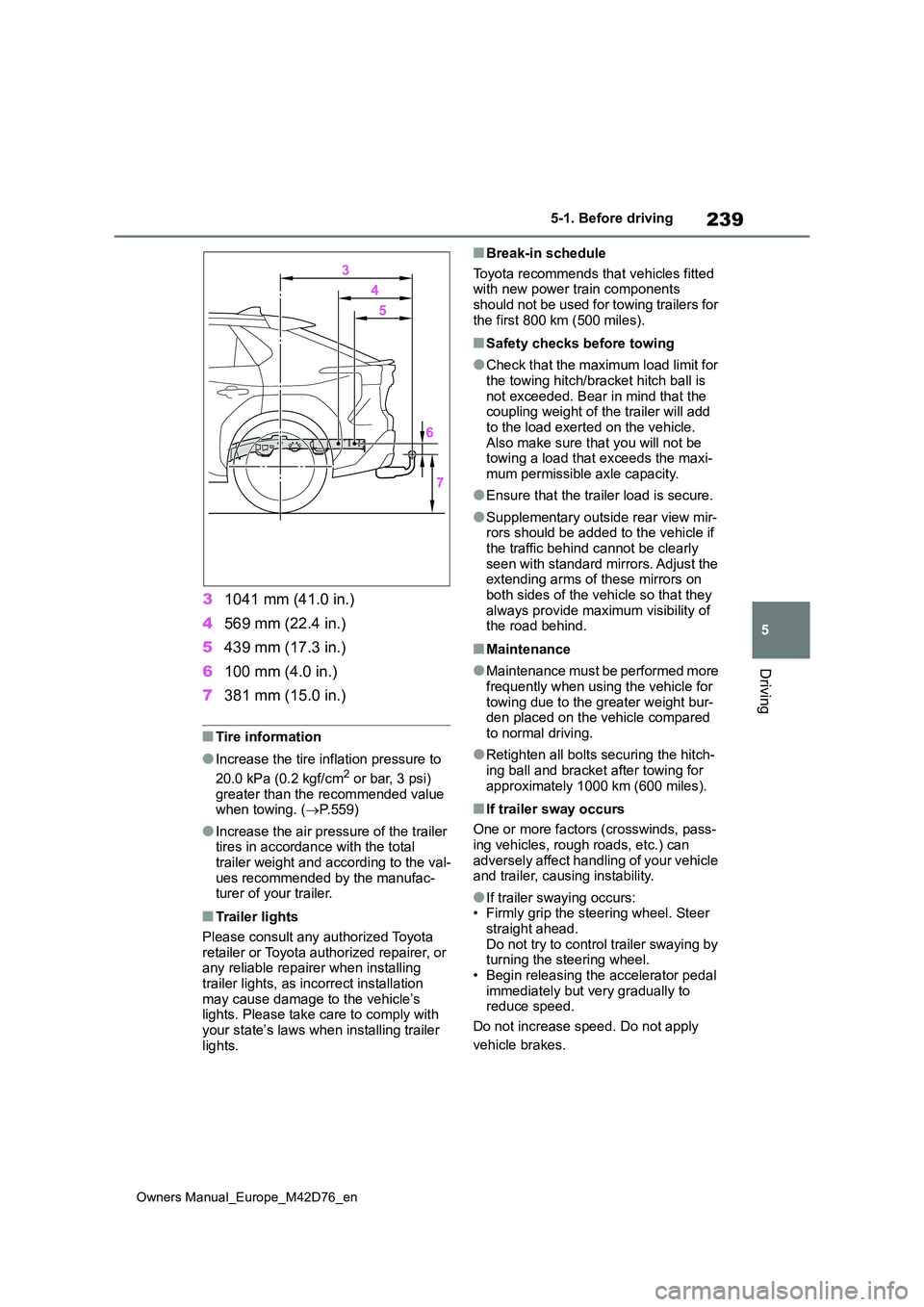
239
5
Owners Manual_Europe_M42D76_en
5-1. Before driving
Driving
31041 mm (41.0 in.)
4 569 mm (22.4 in.)
5 439 mm (17.3 in.)
6 100 mm (4.0 in.)
7 381 mm (15.0 in.)
■Tire information
●Increase the tire inflation pressure to
20.0 kPa (0.2 kgf/cm2 or bar, 3 psi) greater than the recommended value when towing. ( P.559)
●Increase the air pressure of the trailer tires in accordance with the total
trailer weight and according to the val- ues recommended by the manufac-turer of your trailer.
■Trailer lights
Please consult any authorized Toyota retailer or Toyota authorized repairer, or any reliable repairer when installing
trailer lights, as incorrect installation may cause damage to the vehicle’s lights. Please take care to comply with
your state’s laws when installing trailer lights.
■Break-in schedule
Toyota recommends that vehicles fitted with new power train components should not be used for towing trailers for
the first 800 km (500 miles).
■Safety checks before towing
●Check that the maximum load limit for
the towing hitch/bracket hitch ball is not exceeded. Bear in mind that the coupling weight of the trailer will add
to the load exerted on the vehicle. Also make sure that you will not be towing a load that exceeds the maxi-
mum permissible axle capacity.
●Ensure that the trailer load is secure.
●Supplementary outside rear view mir- rors should be added to the vehicle if
the traffic behind cannot be clearly seen with standard mirrors. Adjust the extending arms of these mirrors on
both sides of the vehicle so that they always provide maximum visibility of the road behind.
■Maintenance
●Maintenance must be performed more frequently when using the vehicle for
towing due to the greater weight bur- den placed on the vehicle compared to normal driving.
●Retighten all bolts securing the hitch-ing ball and bracket after towing for
approximately 1000 km (600 miles).
■If trailer sway occurs
One or more factors (crosswinds, pass- ing vehicles, rough roads, etc.) can
adversely affect handling of your vehicle and trailer, causing instability.
●If trailer swaying occurs:• Firmly grip the steering wheel. Steer straight ahead.
Do not try to control trailer swaying by turning the steering wheel.• Begin releasing the accelerator pedal
immediately but very gradually to reduce speed.
Do not increase speed. Do not apply
vehicle brakes.
Page 277 of 674

275
5
Owners Manual_Europe_M42D76_en
5-4. Using the driving support systems
Driving
Toyota Safety Sense
The Toyota Safety Sense con-
sists of the driving assist sys-
tems and contributes to a safe
and comfortable driving expe-
rience:
WARNING
■Toyota Safety Sense
The Toyota Safety Sense operates under the assumption that the driver will drive safely, and is designed to
help reduce the impact to the occu- pants in a collision and assist the driver under normal driving condi-
tions. As there is a limit to the degree of recognition accuracy and control performance that this system can pro-
vide, do not overly rely on this sys- tem. The driver is solely responsible for paying attention to the vehicle’s
surroundings and driving safely.
■For safe use
●Do not overly rely on this system. The driver is solely responsible for paying attention to the vehicle’s sur-
roundings and driving safely. This system may not operate in all situa-tions and provided assistance is
limited. Over-reliance on this sys- tem to drive the vehicle safely may lead to an accident resulting in
death or serious injury.
●Do not attempt to test the operation
of the system, as it may not operate properly, possibly leading to an accident.
●If attention is necessary while per-forming driving operations or a sys-
tem malfunction occurs, a warning message or warning buzzer will be operated. If a warning message is
displayed on the display, follow the instructions displayed.
●Depending on external noise, the volume of the audio system, etc., it may be difficult to hear the warning
buzzer. Also, depending on the road conditions, it may be difficult to recognize the operation of the sys-
tem.
■When it is necessary to disable
the system
In the following situations, make sure to disable the system.
Failure to do so may lead to the sys- tem not operating properly, possibly leading to an accident resulting in
death or serious injury.
●When the vehicle is tilted due to
being overloaded or having a flat tire
●When driving at extremely high speeds
●When towing another vehicle
●When the vehicle is being trans-
ported by a truck, ship, train, etc.
●When the vehicle is raised on a lift
and the tires are allowed to rotate freely
●When inspecting the vehicle using a drum tester such as a chassis dynamometer or speedometer tes-
ter, or when using an on vehicle wheel balancer
●When the vehicle is driven in a sporty manner or off-road
●When using an automatic car wash
●When a sensor is misaligned or
deformed due to a strong impact being applied to the sensor or the area around the sensor
●When accessories which obstruct a sensor or light are temporarily
installed to the vehicle
Page 278 of 674
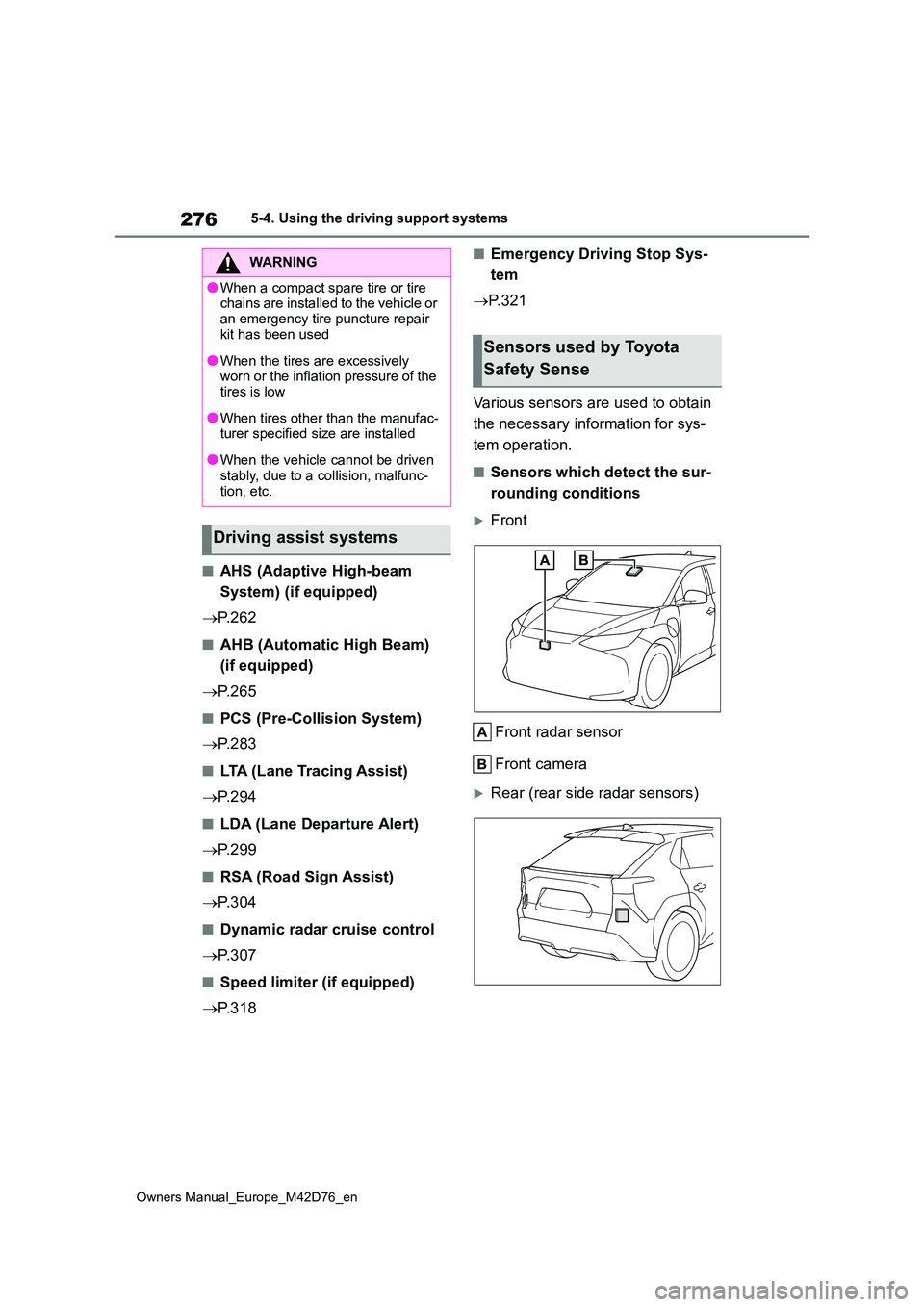
276
Owners Manual_Europe_M42D76_en
5-4. Using the driving support systems
■AHS (Adaptive High-beam
System) (if equipped)
P. 2 6 2
■AHB (Automatic High Beam)
(if equipped)
P. 2 6 5
■PCS (Pre-Collision System)
P. 2 8 3
■LTA (Lane Tracing Assist)
P. 2 9 4
■LDA (Lane Departure Alert)
P. 2 9 9
■RSA (Road Sign Assist)
P. 3 0 4
■Dynamic radar cruise control
P. 3 0 7
■Speed limiter (if equipped)
P. 3 1 8
■Emergency Driving Stop Sys-
tem
P. 3 2 1
Various sensors are used to obtain
the necessary information for sys-
tem operation.
■Sensors which detect the sur-
rounding conditions
Front
Front radar sensor
Front camera
Rear (rear side radar sensors)
WARNING
●When a compact spare tire or tire chains are installed to the vehicle or
an emergency tire puncture repair kit has been used
●When the tires are excessively worn or the inflation pressure of the tires is low
●When tires other than the manufac-turer specified size are installed
●When the vehicle cannot be driven stably, due to a collision, malfunc-
tion, etc.
Driving assist systems
Sensors used by Toyota
Safety Sense